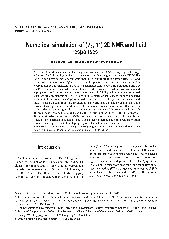摘要
One-dimensional nuclear magnetic resonance (1D NMR) logging technology is limited for fluid typing, while two-dimensional nuclear magnetic resonance (2D NMR) logging can provide more parameters including longitudinal relaxation time (T (1)) and transverse relaxation time (T (2)) relative to fluid types in porous media. Based on the 2D NMR relaxation mechanism in a gradient magnetic field, echo train simulation and 2D NMR inversion are discussed in detail. For 2D NMR inversion, a hybrid inversion method is proposed based on the damping least squares method (LSQR) and an improved truncated singular value decomposition (TSVD) algorithm. A series of spin echoes are first simulated with multiple waiting times (T (W) s) in a gradient magnetic field for given fluid models and these synthesized echo trains are inverted by the hybrid method. The inversion results are consistent with given models. Moreover, the numerical simulation of various fluid models such as the gas-water, light oil-water, and vicious oil-water models were carried out with different echo spacings (T (E) s) and T (W) s by this hybrid method. Finally, the influences of different signal-to-noise ratios (SNRs) on inversion results in various fluid models are studied. The numerical simulations show that the hybrid method and optimized observation parameters are applicable to fluid typing of gas-water and oil-water models.
- 出版日期2012-12
- 单位中国地质大学(北京)
